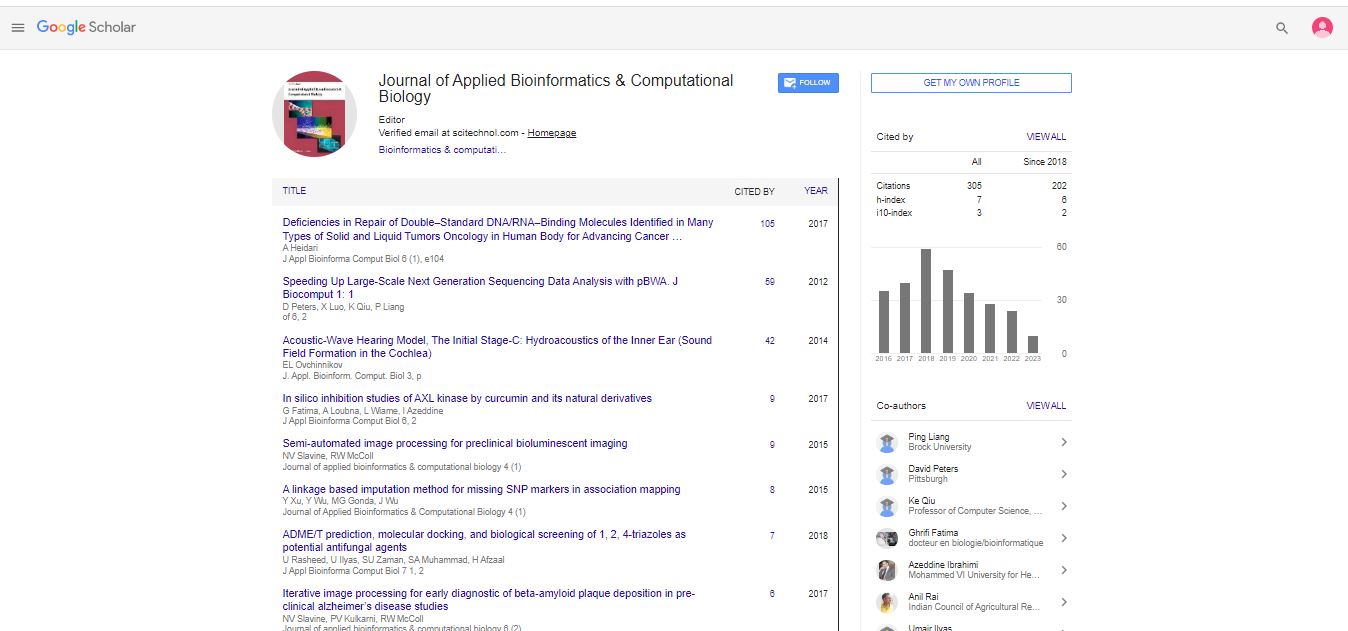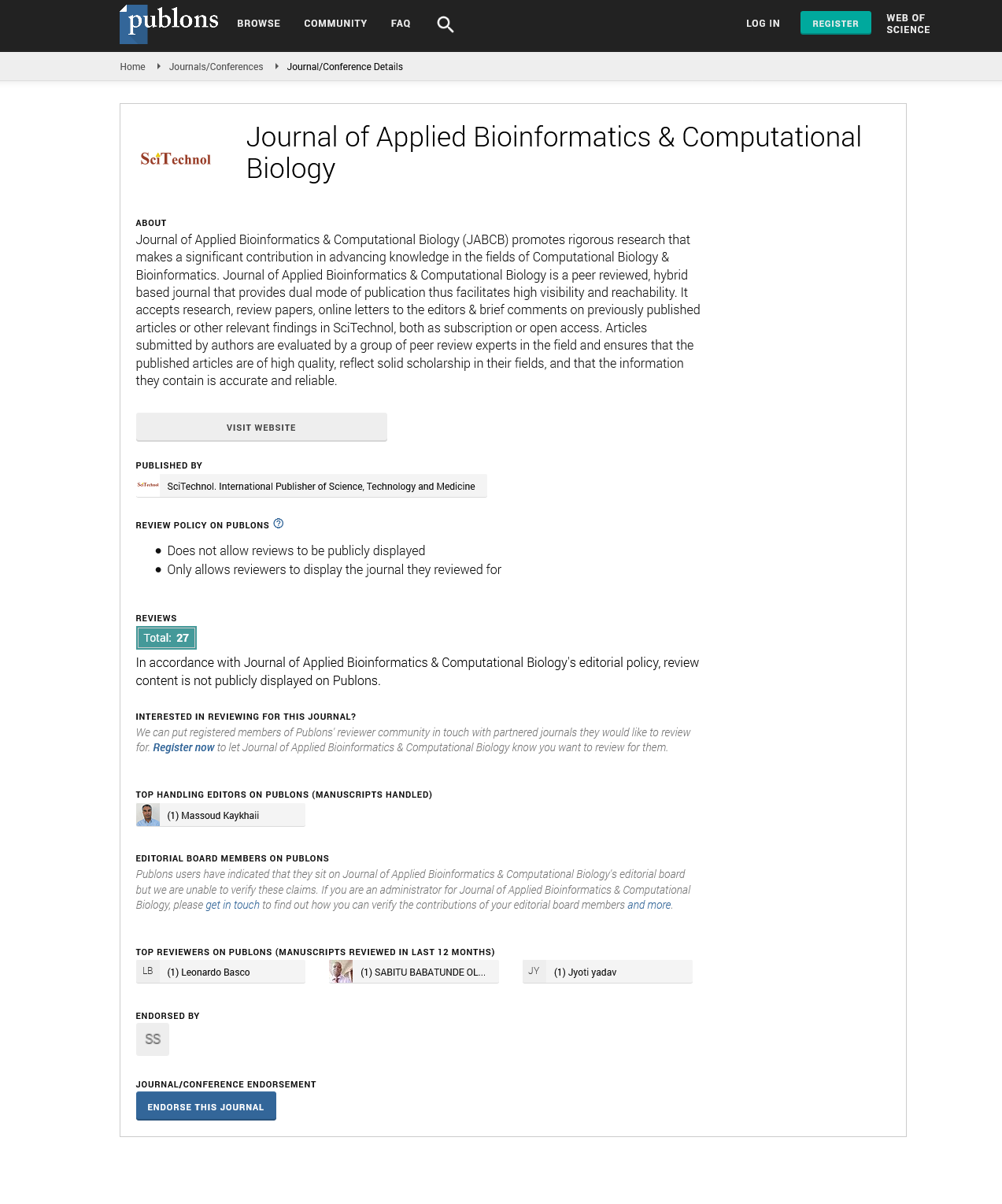Perspective, Vol: 14 Issue: 1
Power of Drug Discovery Tools Software Solutions to Revolutionize Drug Analysis and Research
Muthusamy Suganthi*
Department of Biological Engineering, Qingdao University of Science and Technology, Qingdao, China
*Corresponding Author: Muthusamy Suganthi,
Department of Biological Engineering, Qingdao University of Science and Technology, Qingdao, China
E-mail: suganthim69@gmail.com
Received date: 20 February, 2024, Manuscript No. JABCB-24-127923;
Editor assigned date: 22 February, 2024, PreQC No. JABCB-24-127923 (PQ);
Reviewed date: 04 March, 2024, QC No. JABCB-24-127923;
Revised date: 22 April, 2025, Manuscript No. JABCB-24-127923 (R);
Published date: 29 April, 2025, DOI: 10.4172/2329-9533.1000296
Citation: Suganthi M (2025) Power of Drug Discovery Tools Software Solutions to Revolutionize Drug Analysis and Research. J Appl Bioinforma Comput Biol 14:1.
Introduction
In the dynamic landscape of pharmaceuticals, the quest for novel drugs to combat diseases is an ongoing challenge. Central to this endeavor is the arsenal of drug discovery tools, sophisticated software solutions designed to analyze, study, and research drugs with unparalleled precision and efficiency. These tools represent the cutting edge of scientific innovation, enabling researchers to navigate the complexities of drug development with unprecedented insight and speed.Description
Understanding drug discovery tools
At the heart of drug discovery tools lies a diverse array of software platforms and algorithms, each tailored to address specific facets of the drug development process. From molecular modeling and virtual screening to pharmacokinetic analysis and target identification, these tools offer a comprehensive toolkit for researchers to explore the vast chemical space of potential therapeutics.
Molecular modeling and simulation
One of the cornerstones of drug discovery is molecular modeling, which allows researchers to predict the behavior and interactions of drug molecules at the atomic level. By harnessing powerful computational algorithms, scientists can simulate the threedimensional structures of proteins, receptors, and ligands, providing invaluable insights into drug-target interactions and binding affinities. These simulations not only expedite the process of lead optimization but also enable the rational design of novel drugs with enhanced efficacy and safety profiles.
Virtual screening and high-throughput analysis
In the era of big data, virtual screening has emerged as a gamechanging approach to drug discovery. By leveraging vast databases of chemical compounds, virtual screening algorithms can rapidly identify potential drug candidates with desired pharmacological properties. Coupled with high-throughput screening techniques, these tools enable researchers to evaluate thousands of compounds in-silico, significantly accelerating the pace of drug discovery and optimization.
Pharmacokinetic and ADME analysis
Effective drug candidates must not only exhibit potent therapeutic activity but also possess favorable pharmacokinetic properties. Drug discovery tools facilitate the prediction and analysis of drug Absorption, Distribution, Metabolism, and Excretion (ADME), allowing researchers to assess the bioavailability, toxicity, and stability of potential compounds. By integrating pharmacokinetic data into the drug development process, these tools enable researchers to prioritize lead compounds with optimal pharmacological profiles for further evaluation.
Target identification and drug repurposing
Another key application of drug discovery tools is target identification, which involves elucidating the molecular mechanisms underlying disease pathology and identifying drug gable targets for intervention. Through advanced bioinformatics and data mining techniques, researchers can uncover novel biomarkers, signaling pathways, and therapeutic targets implicated in various diseases. Moreover, drug discovery tools facilitate drug repurposing efforts by identifying existing compounds with potential off-target effects or novel indications, thereby expediting the development of new treatments for unmet medical needs.
Challenges and future directions
Despite their transformative potential, drug discovery tools are not without challenges. The integration of diverse data sources, the validation of computational models, and the interpretation of complex results remain ongoing areas of research and development. Moreover, as the field of drug discovery continues to evolve, so too must the capabilities of software solutions to keep pace with emerging technologies and methodologies.
Looking ahead, the future of drug discovery tools holds immense promise for advancing the frontiers of medicine. By harnessing the power of artificial intelligence, machine learning, and predictive analytics, researchers can unlock new insights into drug-target interactions, predict clinical outcomes, and accelerate the development of personalized therapeutics. With each technological innovation, drug discovery tools bring us one step closer to realizing the full potential of precision medicine and transforming the lives of patients worldwide.
 Spanish
Spanish  Chinese
Chinese  Russian
Russian  German
German  French
French  Japanese
Japanese  Portuguese
Portuguese  Hindi
Hindi 
